Composition and nutritional value of organic detritus
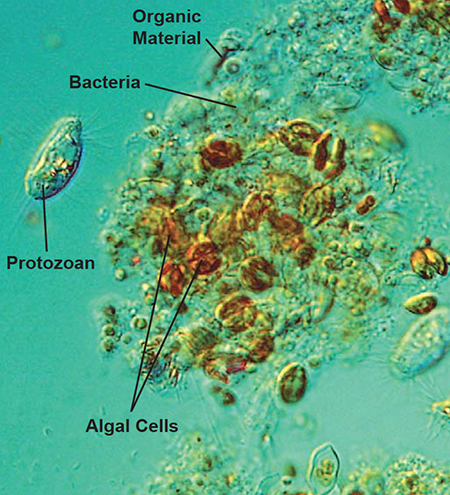
Aerated microbial reuse (AMR) systems utilize intense aeration and mixing to produce yields of 10- 30 metric tons (MT) per hectare per cycle with little or no water exchange. The first in this series of articles reviewed the mechanism of AMR systems, in which an active microbial community reprocesses wastes into detrital food. This second article reviews the nutritional value and composition of detrital material.
Nutritional value of organic detritus
In 1988, Ken Leber and Gary Pruder published exciting research results from the Oceanic Institute in Hawaii, USA. They demonstrated that shrimp reared in microcosms receiving flow-through pond water and fed good-quality diets grew 50 percent faster than shrimp fed identical diets but maintained in clear well water from a seawater aquifer. In 1992, Shaun Moss and his colleagues at Oceanic Institute reported that suspended solids taken from an intensive shrimp pond stimulated the growth of fed shrimp reared in clear well water by 89 percent.
Using a progression of filters, Moss demonstrated that suspended solids in the 0.5 to 5.0 μm range increased growth rates by 53 percent, while solids greater than 5.0 μm increased growth by an additional 36 percent. The solids were characterized as microalgae and microbial-detrital aggregates. The growth-enhancing factor in the suspended solids was not identified, but bacteria were a strong candidate.
Single-cell protein
Over the years, a number of attempts have been made to commercially produce bacteria for sale as “single-cell protein” (SCP). A typical process was the Pruteen technology developed by Imperial Chemical Industries of Billingham, United Kingdom, which produced 6,000 MT per month of Methylophilus methylotrophus bacterium on methanol. However, the economic viability of the process was limited by the expense of concentrating and drying the product.
Single-cell protein performed well as a partial fishmeal replacement in trout diets. In studies with rainbow trout, Pruteen yielded a protein efficiency ratio of 1.62, a net protein utilization value of 0.38, a true digestibility value of 91.2, and a biological value of 0.41. Corresponding values for casein and fishmeal were protein efficiency ratio of 1.97 and 1.91, net protein ratio of 0.40 and 0.38, true digestibility of 98.7 and 91.2, and biological value of 0.41 and 0.41, respectively.
https://www.aquaculturealliance.org/advocate/advantages-of-aerated-microbial-reuse-systems-with-balanced-cn-part-1/
Economic viability
The economic viability of singlecell protein production was limited by the expense of concentrating, drying, and packaging. However, these steps are eliminated in aerated microbial reuse (AMR) systems, where the proteins are consumed in situ by the target animals, with no handling costs. Thus, AMR could represent the first commercially viable case of singlecell protein culture and utilization.
Composition of organic detritus
In the April 2000 Global Aquaculture Advocate, Robins McIntosh of Belize Aquaculture Ltd. analyzed suspended floc from commercial shrimp ponds managed as AMR systems in Belize. He found higher protein levels in suspended floc than in the feeds they were derived from (Table 1).
As reported in the April 2000 Advocate, Albert Tacon filtered suspended detrital floc from outdoor AMR tanks at Oceanic Institute in Hawaii at the end of a 56-day shrimp feeding trial. Chemical analyses of this material revealed a protein content similar to a 35 percent protein pelleted shrimp diet (Table 1).
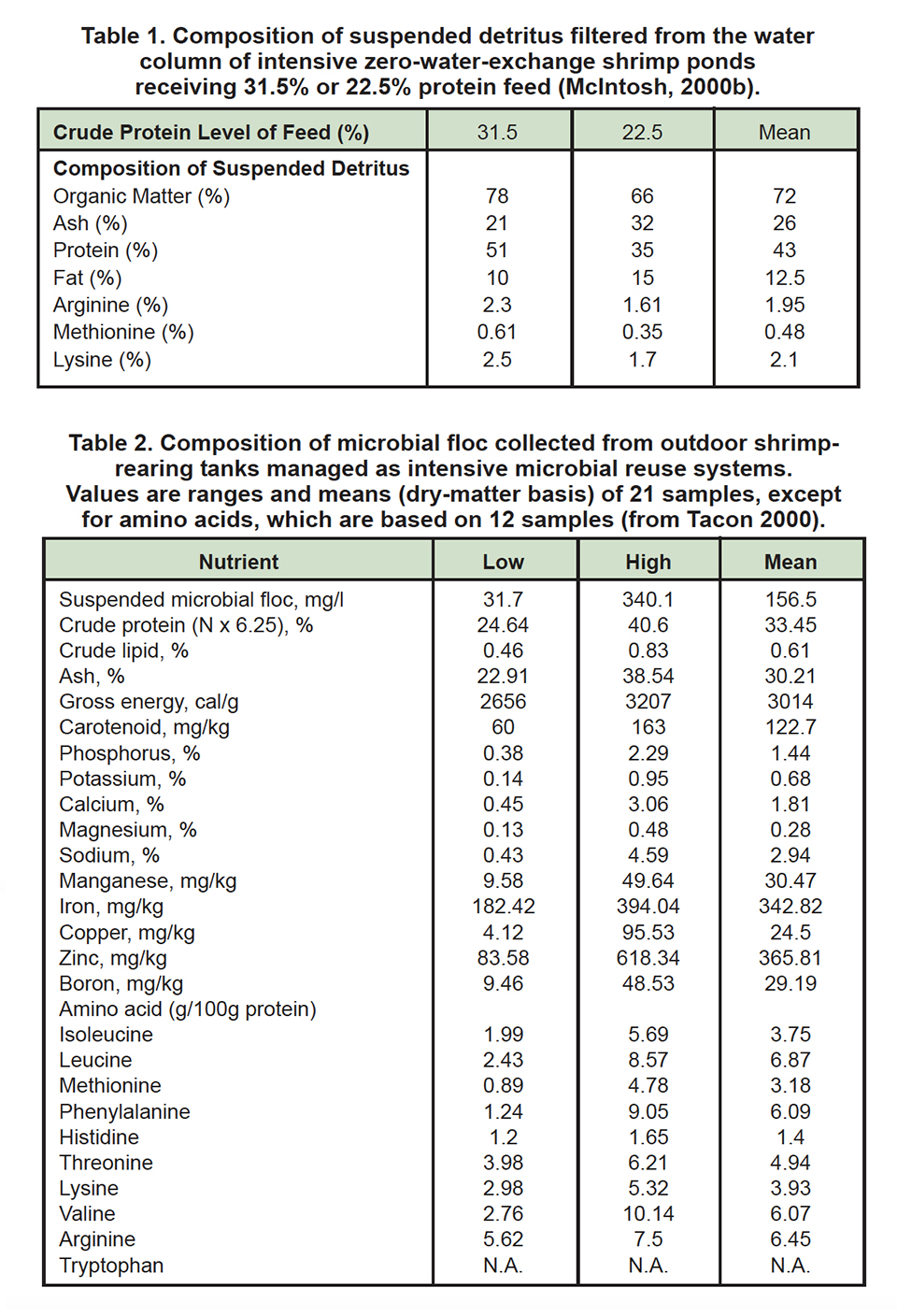
Lipids
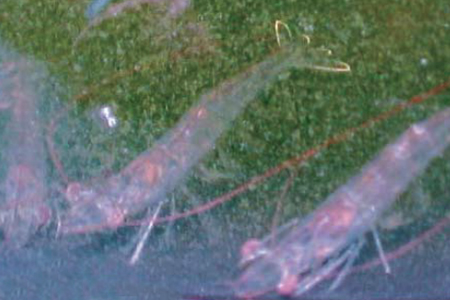
Lipid analyses of floc by McIntosh and Tacon revealed dissimilar results. McIntosh found high lipid levels (mean = 12.5 percent), while Tacon found low levels (mean = 0.61 percent). According to Litchfield (1990), the composition of microbial cells in suspended flocs varies widely depending on specific organisms and the conditions under which they are grown.
Substrate carbon:nitrogen ratios of 10:1 or less favor bacteria with high protein contents, while higher C:N ratios favor the accumulation of lipids in algae, yeasts and molds, and poly- β-hydroxybutyrate in bacteria. This implies that microbial feed composition can be manipulated to some extent to maximize nutritional value.
Amino acids
McIntosh reported floc amino acid levels that were adequate in lysine and arginine content, but somewhat deficient in methionine to meet shrimp nutritional requirements (Table 1). However, Tacon reported adequate levels of arginine and methionine and deficient levels of lysine (Table 2). In general, microbial proteins tend to be deficient in sulfur amino acids, although bacterial proteins are less deficient than algae, yeast, molds, or higher fungi.
Ash
Both McIntosh and Tacon measured high levels of ash (mean of 26.0 and 30.2, respectively) in suspended flocs. Analysis of minerals indicates that microbial floc is rich in phosphorus as well as a wide range source of other minerals (Table 2). Much of this mineral composition can be bound to bacteria in a bioavailable organic form.
Phosphorus
 Velasco et al. (1998) tested three levels of dietary phosphorus – 0.4, 0.8 and 1.2 percent – for postlarval shrimp reared in indoor AMR tanks. The accumulation of total reactive phosphate in the water increased significantly with increasing dietary phosphorus level. This suggests that dietary phosphorus levels can be reduced in these systems, due to recycling.
Velasco et al. (1998) tested three levels of dietary phosphorus – 0.4, 0.8 and 1.2 percent – for postlarval shrimp reared in indoor AMR tanks. The accumulation of total reactive phosphate in the water increased significantly with increasing dietary phosphorus level. This suggests that dietary phosphorus levels can be reduced in these systems, due to recycling.
Vitamins
Tacon reported that supplemental vitamins in shrimp feed can be completely dispensed in an AMR microcosm system used for feeding trials. This also was observed by Velasco and Lawrence (2000) in initial evaluations of vitamin requirements in indoor AMR tanks.
Conclusion
Although bacterial floc can be an important growth promoter and nutritional supplement, it is not ideal as a sole source of nutrition. Microbial cells contain higher levels of nucleic acid nitrogen and non-protein nitrogen than higher organisms. Typically, nucleic acid levels, mainly ribonucleic acid, range 8 to 25 grams per 100 g protein (dry-weight basis). The ratio of Kjeldahl nitrogen to true protein in microbial cells is in the range of 5.6 to 5.8, as opposed to the typical ratio of 6.25 for plants and animals (Litchfield, 1990).
Feeding trials with a variety of species have demonstrated growth suppression when microbial cells are used as the sole source of protein in the diet. Consequently, microbial proteins are considered only a supplemental feed in AMR systems.
(Editor’s Note: This article was originally published in the June 2001 print edition of the Global Aquaculture Advocate.)
Now that you've reached the end of the article ...
… please consider supporting GSA’s mission to advance responsible seafood practices through education, advocacy and third-party assurances. The Advocate aims to document the evolution of responsible seafood practices and share the expansive knowledge of our vast network of contributors.
By becoming a Global Seafood Alliance member, you’re ensuring that all of the pre-competitive work we do through member benefits, resources and events can continue. Individual membership costs just $50 a year.
Not a GSA member? Join us.
Authors
-

George Chamberlain, Ph.D.
Global Aquaculture Alliance
St. Louis, Missouri, USA -
Yoram Avnimelech, Ph.D.
Faculty of Agricultural Engineering Technion
Israel Institute of Technology
Haifa, Israel -

Robins P. McIntosh
Belize Aquaculture, Ltd.
Belize City, Belize -
Mario Velasco, Ph.D.
Empacadora Nacional C.A.
Guayaquil, Ecuador
Tagged With
Related Posts
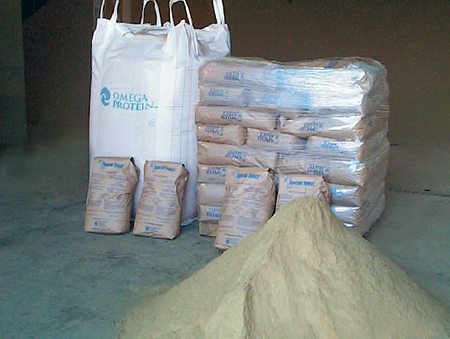
Aquafeeds
Mexico research studies digestibility in fishmeals
Fishmeal quality is dependent on the freshness of the fish, oxidation of the fats and digestibility. Protein digestibility depends on processing conditions.

Responsibility
Effluent effects from aquaculture ponds
In general, lower-intensity pond and cage farming tends to discharge higher overall pollution loads in farm effluents than closed aquaculture systems.
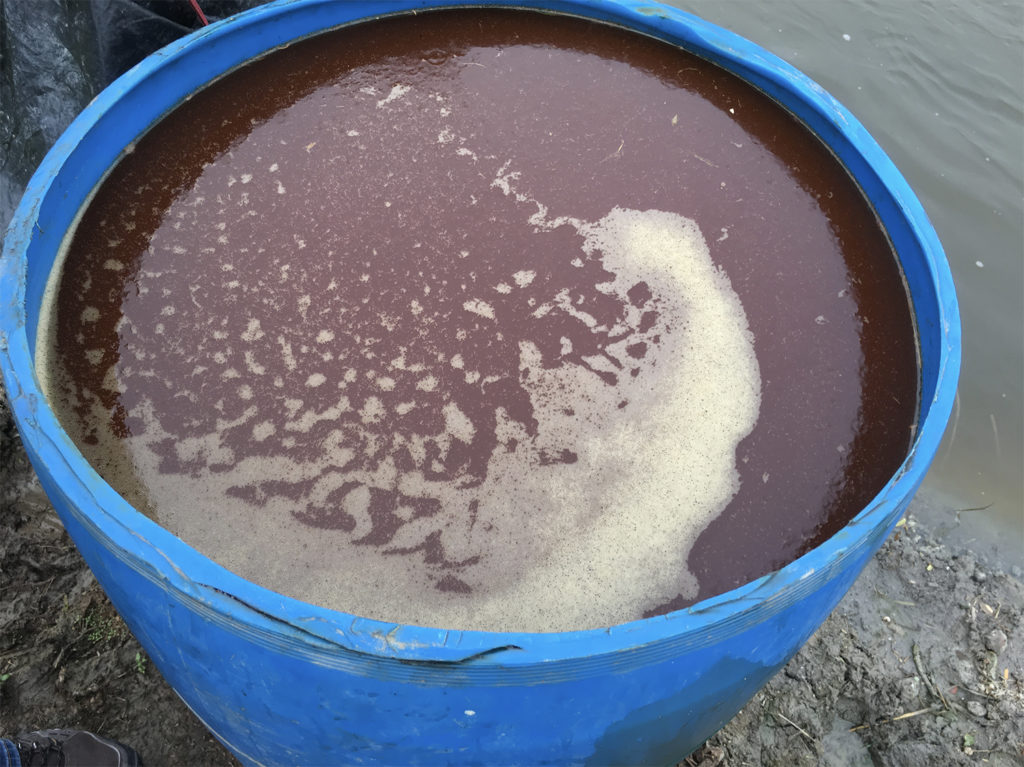
Responsibility
Bacterial amendments in shrimp grow-out ponds
Pond microbial communities are a critical and often overlooked component of aquaculture ecosystems. Bacterial amendments like probiotics provide significant support to shrimp farmers around the world.
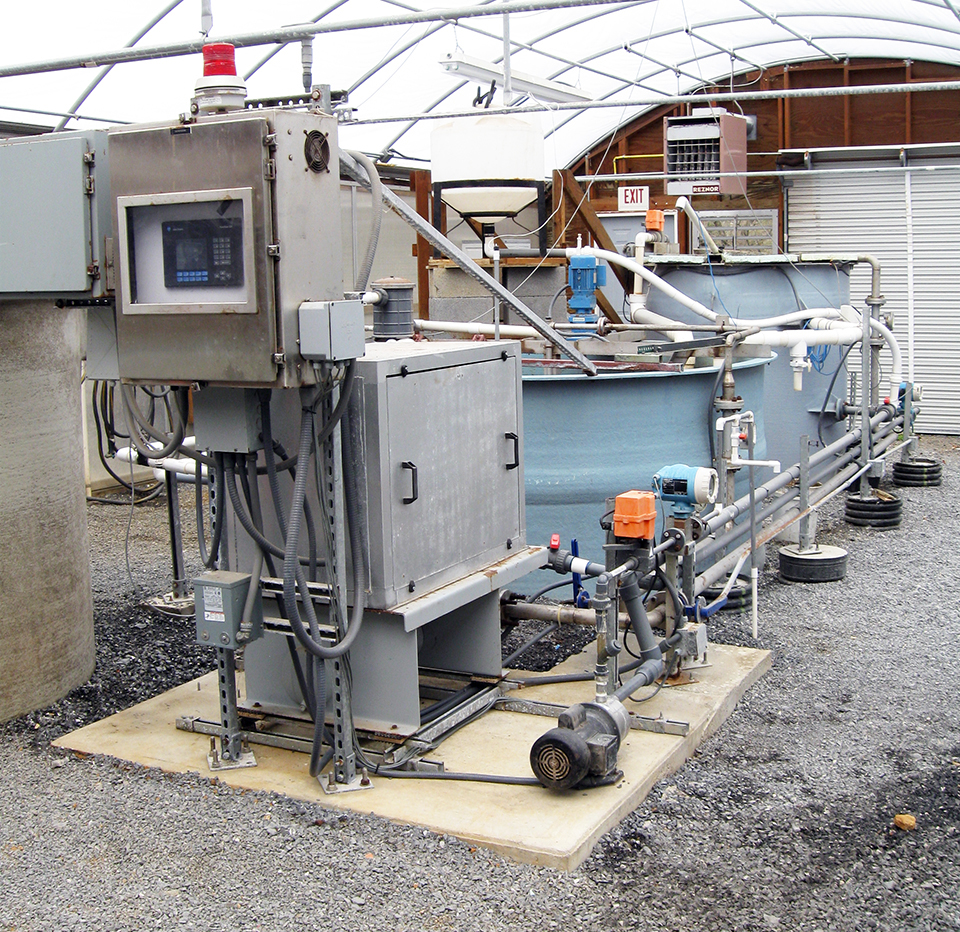
Responsibility
Membrane biological reactors provide wastewater treatment, resource reclamation
Membrane biological reactors provide wastewater treatment by utilizing activated sludge to remove nitrogen, phosphorus and biological oxygen demand. The reactors also have the potential for nearly complete water recovery in fish culture systems.


